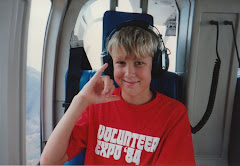 I've been avoiding making another post because I just didn't know what to say. When I returned home in mid-August from six weeks of full-time helicopter school in Hawaii, I came back to my life and job and uncertainty about how to continue with helicopters.
I've been avoiding making another post because I just didn't know what to say. When I returned home in mid-August from six weeks of full-time helicopter school in Hawaii, I came back to my life and job and uncertainty about how to continue with helicopters.On the one hand, learning to fly was, and is, an incredible experience. Now when I see a helicopter flying, I smile and reflect on the bond and shared knowledge and experience I have with that other pilot. Not many people know what it feels like, and now I do. Plus, being up in the air like a bird is an incredible feeling, and I'd like to feel it more.
On the other hand, I'm not sure I can, or should, continue -- at least not right now. The fact is, flying helicopters is an incredibly difficult endeavor, requiring vast knowledge and experience.
As it stands, I've got around 30 hours of experience in the air, about halfway to my private pilot's license. I could crank out the rest of the license on weekends over the next several months, but the problem is, that's not really an end in itself.
As one instructor put it, the private rating means you know just enough to get yourself killed. Now that I've had a taste of flying, I agree with him. True competency requires at least a commercial pilot's rating, which is a whole additional level of investment in money and time.
 I must admit that when I started this, I had no idea how much was required. It's a very technical, professional skill, not unlike being a lawyer or a doctor. It requires literally years of full-time study and training to become competent. That would be a huge investment to make in something I'm not planning on doing professionally -- not unlike, say, going law school just because I find law interesting. Hardly practical.
I must admit that when I started this, I had no idea how much was required. It's a very technical, professional skill, not unlike being a lawyer or a doctor. It requires literally years of full-time study and training to become competent. That would be a huge investment to make in something I'm not planning on doing professionally -- not unlike, say, going law school just because I find law interesting. Hardly practical.More importantly, it's a use-it-or-lose-it skill. In order to stay competent, and consequently safe, a helicopter pilot really needs to be flying all the time, at least every week or so. So, I could get my private license, but to stay safe, I would need to fly often, which is very expensive.
 Which brings me to my final consideration: money. As I write this, the United States and the world are in a dramatic economic downturn that is affecting just about everyone on the planet to some degree. The stock market has crashed, and consequently the assets I was using to fund my helicopter adventure have been significantly devalued. Selling stock now would be a bad mistake.
Which brings me to my final consideration: money. As I write this, the United States and the world are in a dramatic economic downturn that is affecting just about everyone on the planet to some degree. The stock market has crashed, and consequently the assets I was using to fund my helicopter adventure have been significantly devalued. Selling stock now would be a bad mistake.So even if I wanted to continue with helicopter school right now, and part of me really wants to, the economic situation renders it moot.
I've been avoiding this post, because I felt I was facing failure. I didn't want to admit after all my enthusiasm and hype that I was, well...quitting.
But now that I've written it, I don't feel that way.
The truth is, my experience in Hawaii was incredible. Facing my fear of heights was an enormous achievement, and I can look back on that for confidence in any future endeavor.
 And although I didn't blog about it, my time in Hawaii also led me to grow in other very important ways, such as in my family relationships (family pictured), as well as my personal health. This blog, as well, was part of that experience, and it's been unexpectedly rewarding. The response to my writing has been very flattering and encouraging.
And although I didn't blog about it, my time in Hawaii also led me to grow in other very important ways, such as in my family relationships (family pictured), as well as my personal health. This blog, as well, was part of that experience, and it's been unexpectedly rewarding. The response to my writing has been very flattering and encouraging.I do feel wistful that I didn't complete my license as originally planned. But my real goal was to learn to fly a helicopter, and I did that.
I began this adventure by saying that a journey of a thousand miles begins with a single step. I took that step, and now the journey continues. Whether or not my path will one day cross back through this place, I cannot say.
So, until then, I'll leave you with this thought from my first day of helicopter school, when even hovering seemed beyond my reach:
The only difference between impossible and possible is belief.
Don't forget that.
P.S. Any travelers who should happen upon my words here can probably reach me at jake(-AT-)jakesibley.com. I'll be glad to hear from you.











